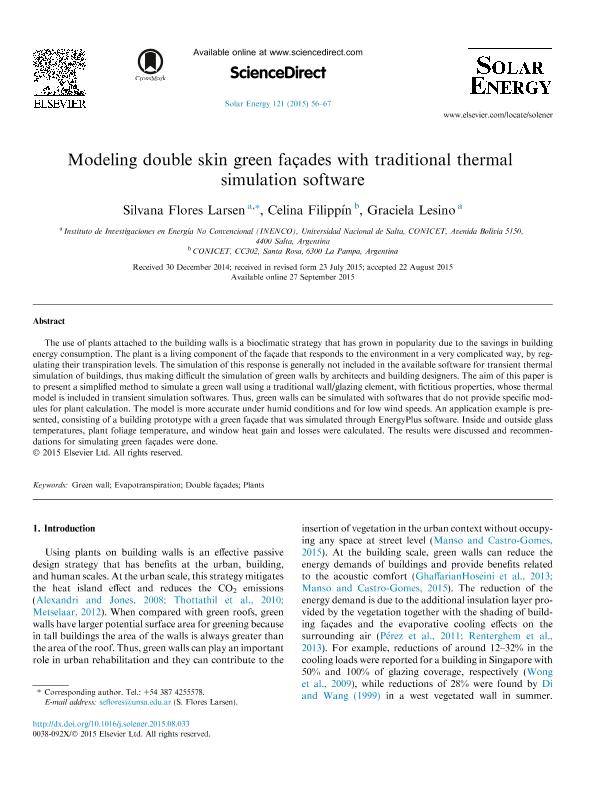Mostrar el registro sencillo del ítem
dc.contributor.author
Flores Larsen, Silvana Elinor

dc.contributor.author
Filippin, Maria Celina

dc.contributor.author
Lesino, Graciela

dc.date.available
2018-04-20T17:02:35Z
dc.date.issued
2015-09
dc.identifier.citation
Flores Larsen, Silvana Elinor; Filippin, Maria Celina; Lesino, Graciela; Modeling double skin green façades with traditional thermal simulation software; Pergamon-Elsevier Science Ltd; Solar Energy; 121; 9-2015; 56-67
dc.identifier.issn
0038-092X
dc.identifier.uri
http://hdl.handle.net/11336/42838
dc.description.abstract
The use of plants attached to the building walls is a bioclimatic strategy that has grown in popularity due to the savings in building energy consumption. The plant is a living component of the façade that responds to the environment in a very complicated way, by regulating their transpiration levels. The simulation of this response is generally not included in the available software for transient thermal simulation of buildings, thus making difficult the simulation of green walls by architects and building designers. The aim of this paper is to present a simplified method to simulate a green wall using a traditional wall/glazing element, with fictitious properties, whose thermal model is included in transient simulation softwares. Thus, green walls can be simulated with softwares that do not provide specific modules for plant calculation. The model is more accurate under humid conditions and for low wind speeds. An application example is presented, consisting of a building prototype with a green façade that was simulated through EnergyPlus software. Inside and outside glass temperatures, plant foliage temperature, and window heat gain and losses were calculated. The results were discussed and recommendations for simulating green façades were done.
dc.format
application/pdf
dc.language.iso
eng
dc.publisher
Pergamon-Elsevier Science Ltd

dc.rights
info:eu-repo/semantics/openAccess
dc.rights.uri
https://creativecommons.org/licenses/by-nc-sa/2.5/ar/
dc.subject
Green Wall
dc.subject
Evapotranspiration
dc.subject
Double FaÇAdes
dc.subject
Plants
dc.subject.classification
Otras Ingeniería Eléctrica, Ingeniería Electrónica e Ingeniería de la Información

dc.subject.classification
Ingeniería Eléctrica, Ingeniería Electrónica e Ingeniería de la Información

dc.subject.classification
INGENIERÍAS Y TECNOLOGÍAS

dc.title
Modeling double skin green façades with traditional thermal simulation software
dc.type
info:eu-repo/semantics/article
dc.type
info:ar-repo/semantics/artículo
dc.type
info:eu-repo/semantics/publishedVersion
dc.date.updated
2018-04-17T13:57:27Z
dc.journal.volume
121
dc.journal.pagination
56-67
dc.journal.pais
Estados Unidos

dc.journal.ciudad
Amsterdam
dc.description.fil
Fil: Flores Larsen, Silvana Elinor. Consejo Nacional de Investigaciones Científicas y Técnicas. Centro Científico Tecnológico Conicet - Salta. Instituto de Investigaciones en Energía no Convencional. Universidad Nacional de Salta. Facultad de Ciencias Exactas. Departamento de Física. Instituto de Investigaciones en Energía no Convencional; Argentina
dc.description.fil
Fil: Filippin, Maria Celina. Consejo Nacional de Investigaciones Científicas y Técnicas; Argentina
dc.description.fil
Fil: Lesino, Graciela. Consejo Nacional de Investigaciones Científicas y Técnicas. Centro Científico Tecnológico Conicet - Salta. Instituto de Investigaciones en Energía no Convencional. Universidad Nacional de Salta. Facultad de Ciencias Exactas. Departamento de Física. Instituto de Investigaciones en Energía no Convencional; Argentina
dc.journal.title
Solar Energy

dc.relation.alternativeid
info:eu-repo/semantics/altIdentifier/doi/http://dx.doi.org/10.1016/j.solener.2015.08.033
dc.relation.alternativeid
info:eu-repo/semantics/altIdentifier/url/https://www.sciencedirect.com/science/article/pii/S0038092X15004697
Archivos asociados
